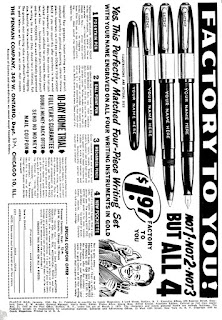I saw a picture of a crime comics cover years ago, and the title stuck in my head: Seven Dead Men. It is an intriguing title, but what got my attention was the garish cover lettering.It was another example of a comic book fighting to command attention on newsstands, and probably succeeding. It came out in 1948, which was the year that newsstands saw an onslaught of crime comics.
I didn’t see the actual comic until much later. The title is officially Complete Mystery #1, in small print. It is a private eye story; a tale of some hidden stolen loot and some gangsters getting bumped off by a guy looking for that loot.
Best information on the creators are from Dr Michael J Vassallo, who knows more about the magazine and comic book empire of publisher Martin Goodman than anyone. In the Grand Comics Database he says that it is Gene Colan’s pencil art with an unknown inker, and script by Stan Lee. There are no credits for either the short “Tommy Tyme” story or the U.S. Post Office's requirement for two pages of text material, “The Stuffed Rubber.”
I showed the lead story in 2014. These are new scans of the entire book.
Sunday, June 28, 2020
Sunday, June 21, 2020
Number 2438: Jack Cole stretched the limits of comic art
Jack Cole had a long career for a man whose life ended at age 43. He was a gifted cartoonist whose magnum opus (as far as I’m concerned) was Plastic Man.
Cole began drawing for comics in the late '30s. After leaving comic books in the early '50s Cole drew sexy cartoons for Playboy as “Cole” and also for the digest-sized cartoon magazines made for men, full of sexist jokes and pretty girls as “Jake.” I knew none of that in 1956 when I found the last issue of Plastic Man, #64, on a comic book spinner. On the basis of that issue I became a Jack Cole/Plastic Man fan.
Cole stopped signing his name after awhile, perhaps because he didn’t want his name associated any more with comic books, under constant fire since their beginnings in the late '30s. But true Cole art comes out of each page that Cole had anything to do with.
Today I’m presenting the issue of Plastic Man #21 from 1950. I think Cole did most, if not all, of the penciling and probably the inking of the main characters in each of the three stories. I am not sure how it worked at Quality Comics in those days, and I admit that unlike some fans who know more than me, I am guessing based on my own observations of Cole’s artwork for over 60 years.
Cole began drawing for comics in the late '30s. After leaving comic books in the early '50s Cole drew sexy cartoons for Playboy as “Cole” and also for the digest-sized cartoon magazines made for men, full of sexist jokes and pretty girls as “Jake.” I knew none of that in 1956 when I found the last issue of Plastic Man, #64, on a comic book spinner. On the basis of that issue I became a Jack Cole/Plastic Man fan.
Cole stopped signing his name after awhile, perhaps because he didn’t want his name associated any more with comic books, under constant fire since their beginnings in the late '30s. But true Cole art comes out of each page that Cole had anything to do with.
Today I’m presenting the issue of Plastic Man #21 from 1950. I think Cole did most, if not all, of the penciling and probably the inking of the main characters in each of the three stories. I am not sure how it worked at Quality Comics in those days, and I admit that unlike some fans who know more than me, I am guessing based on my own observations of Cole’s artwork for over 60 years.










































































